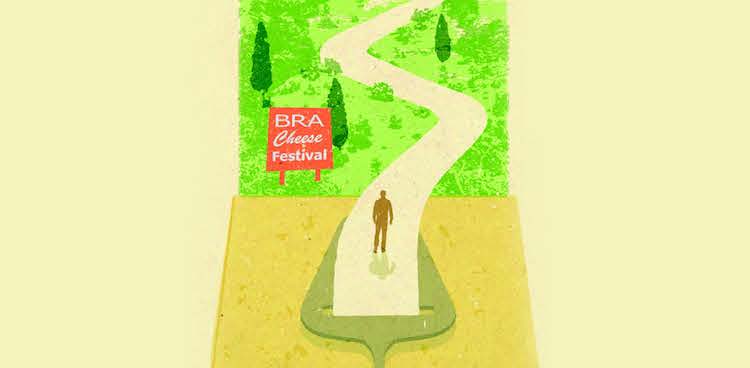
It was the eve of my first experience at the biennial Slow Food Cheese Festival, and already I felt as though I couldn’t bring myself to eat another bite. I’d been cooped up for hours tasting cheese as an apprentice at the Giolito Formaggi shop in Bra, Italy, trying to finalize the selection that owner Fiorenzo Giolito and I would present at the festival. We’d nearly filled our case with cheeses from Italy’s northwestern Piedmont region and needed to add just one more.
Fiorenzo was adamant that the choice be local and rousing, especially given Bra’s historical reputation as a trading and aging hub. We’d sampled nearly every cheese in the shop, and I was sleepy from too much red wine.
“Marset e abbiamo finito!” I declared. “Marset and we’re done!” Fiorenzo sat silently for a moment, then raised his glass. We added a stack of Marset, the refermented version of the town’s name- sake Bra Duro cheese, known for its spicy, nose-burning effects. This was sure to surprise the 150,000-plus participants who would flood the cobblestone streets in the morning.
As I climbed the stairs to my room above the shop, I felt sadness underpinning my excitement. The Cheese festival marked the culmination of my experience in Bra. I’d never imagined I’d live above an Italian cheese shop, much less be mentored by its owner. Now, it felt impossible to leave.
I’d discovered Giolito Formaggi a year earlier. Having recently quit a corporate job in Boston, I was in Italy to pursue a master’s degree in food studies. A cheerful cheese shop owner eager to hand out samples helped grease the wheels of my transition and made me more comfortable with the fact that I had no idea what came next.
I fell hard for rounds wrapped in hay, aged in wine must, or laden with untamed coats of mold that made me sneeze and shiver. I realized that expensive cheese wasn’t only produced or consumed by the elite. These cheesemakers had roots so deep in traditional techniques they couldn’t imagine a life without morning milkings. Their products were worth every centesimo.
I found myself happier in this routine than at any previous job. But I couldn’t imagine that the welcome mat of a shop that closed most days from noon to 4 p.m. was the first step in my new career path. Would I only be able to indulge in this lifestyle of craft and conviviality in Italy?
I was still uncertain about my future when the festival began the next morning. Masses of industry professionals from around the globe moved through the streets, tasting cheeses from countries they’d never visited and breeds they’d only heard of. For the first hour or so, I barely spoke as I wove my way through tents teeming with unusual finds: Kenyan Pokot ash yogurt; Branza de Burduf cheese wrapped in fir tree bark from Transylvania; and Seirass, a velvety mixed-milk Piemontese ricotta. I sipped wine and listened to the steady satisfied moan that emanated throughout the town as mouths met delights.
These were people doing what they loved, finding a huge appetite for their products, and literally preserving their culture in the process. Surrounded by farmers, cheesemakers, sellers, distributors, researchers, activists, and entrepreneurs, I was acutely aware that the world of cheese was alive, and suddenly, I was sure I wanted a piece of it.
That evening, as I walked home, I thought about whom I had become over the past year. Just as I was falling asleep, it finally came to me: “hard, slightly nutty, and primed to age a bit longer, perhaps right here in Bra.”



